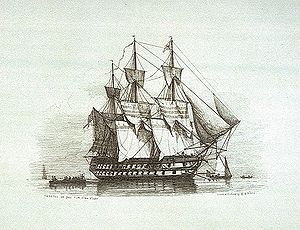HMS Canopus (1798)

| |
| History | |
|---|---|
| Name | Franklin |
| Namesake | Benjamin Franklin |
| Builder | Toulon |
| Laid down | November 1794 |
| Launched | 25 June 1797 |
| Completed | By March 1798 |
| Captured | 2 August 1798, by the Royal Navy |
| Name | HMS Canopus |
| Namesake | The star Alpha Carinae and Canopus, Egypt near Aboukir Bay, site of the Battle of the Nile |
| Acquired | 2 August 1798 |
| Fate | Sold for breaking up in October 1887 |
| General characteristics | |
| Class and type | 84-gun third rate ship of the line |
| Tons burthen | 2,258 77/94 bm |
| Length |
|
| Beam | 51 ft 6.75 in (15.7 m) |
| Depth of hold | 23 ft 4.5 in (7.12 m) |
| Propulsion | Sails |
| Sail plan | Full-rigged ship |
| Complement | 700 |
| Armament |
|
HMS Canopus was an 84-gun
Her career began as the
Construction and French career
Franklin was built to a design by
Franklin's fight
Franklin, positioned just ahead of Brueys's flagship, the 120-gun Orient, and astern of the 74-gun Peuple Souverain, came under fire from HMS Orion, HMS Majestic and HMS Defence.[4] The British ships and the French centre exchanged a heavy fire, with the British being joined by the newly arrived HMS Swiftsure, HMS Alexander and HMS Leander.[4] As Du Chayla later recalled 'The action in this part then became extremely warm.'[5] The two sides were intensely engaged for the next hour, during which the Peuple Souverain was forced out of the line, and the Orient caught fire.[5] As the fire on Orient raged out of control, the nearby French and British ships scrambled to escape the anticipated explosion. Orient's magazine blew up at 9:37 p.m., obliterating her and sending burning debris raining down on the nearby ships.[6] Large amounts fell upon the Franklin, starting fires which caused the arms locker to explode and set fire to the poop and quarterdeck.[2]

For a while it seemed that Franklin would also be burnt, but her crew were able to put out the fires.[2] With Brueys killed aboard Orient, Du Chayla now became commander. Both he and Captain Gillet had been seriously wounded and taken below, but he continued to order the attack.[2] The brief quiet that had resulted from the explosion of the Orient was broken by Franklin's guns, and the battle resumed.[2] She fought for another hour, but by then she had lost her main and mizzenmasts, nearly all of her cannons had been knocked out, and over half her crew were dead or wounded. She finally struck her colours.[2]
British service
Mediterranean and San Domingo
The Franklin was one of nine ships captured by the British at the Nile, and she was taken into service with the Royal Navy, being registered under the name HMS Canopus on 9 December 1798.[1] She was sent back to Britain under the command of Captain Bartholomew James, and arrived at Plymouth on 17 July 1799.[1] She briefly became the flagship of Admiral Philip Affleck for service off Lisbon, but was paid off into ordinary in August that year.[1] She began a refit at Plymouth in August 1801, but the work was suspended incomplete in November that year, and was only completed in January 1803. She recommissioned in April that year under the command of Captain John Conn, and became the flagship of Rear-Admiral George Campbell.[1]

Canopus was sent in August 1803 to join the
Shortland was succeeded by Captain
Postwar
A large repair was carried out at Plymouth Dock (i.e. Devonport) for the sum of £78,909 between March 1814 and March 1816, but with the end of the Napoleonic Wars she was laid up for a number of years. Canopus was fitted for sea at Devonport in May 1834, and underwent further repairs between December 1839 and May 1842.
Notes
- ^ a b c d e f g h i j k l m n o p q r s Winfield. British Warships of the Age of Sail 1794-1817. p. 321.
- ^ a b c d e f Mostert. The Line Upon the Wind. p. 271.
- ^ Mostert. The Line Upon the Wind. p. 260.
- ^ a b Mostert. The Line Upon the Wind. p. 268.
- ^ a b Mostert. The Line Upon the Wind. p. 269.
- ^ Mostert. The Line Upon the Wind. p. 270.
- ^ "- National Maritime Museum".
- ^ Tracy. Who's who in Nelson's Navy. p. 15.
- ^ Fremont-Barnes. The Royal Navy: 1793-1815. p. 86.
- The European Magazine, and London Review. p. 57.
- ^ Colledge. Ships of the Royal Navy. p. 59.
References
- ISBN 978-1-86176-281-8.
- Philological Society (Great Britain) (1810). The European Magazine, and London Review. Vol. 57. London: Philological Society of London.
- Fremont-Barnes, Gregory (2007). The Royal Navy: 1793-1815. Oxford: Osprey Publishing. ISBN 978-1-84603-138-0.
- Mostert, Noel (2008). The Line Upon a Wind: The Greatest War Fought At Sea Under Sail: 1793-1815. London: Vintage Books. ISBN 978-0-7126-0927-2.
- Tracy, Nicholas (2006). Who's who in Nelson's Navy: 200 Naval Heroes. London: Chatham Publishing. ISBN 1-86176-244-5.
- Winfield, Rif (2007). British Warships of the Age of Sail 1794–1817: Design, Construction, Careers and Fates. Seaforth. ISBN 978-1-86176-246-7.
